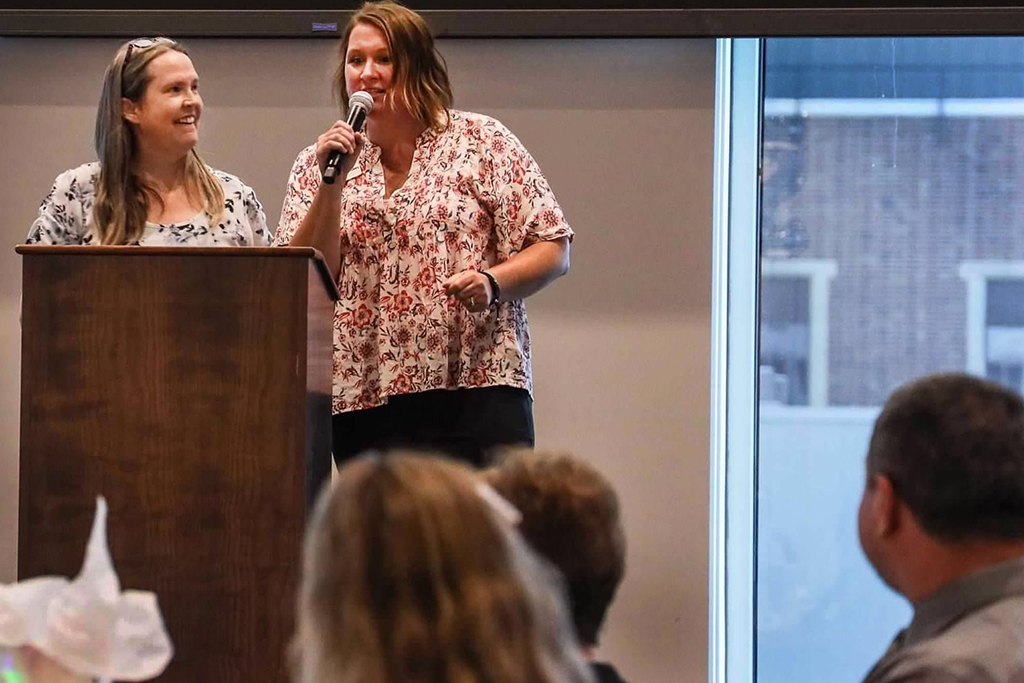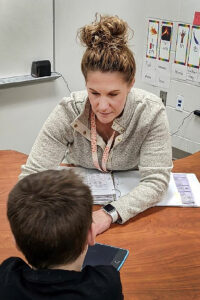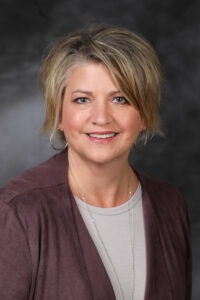Very special Special Education master’s program celebrates 25 years
Layered mentorship is at core of UND’s successful Special Education Resident Teacher Program

Rebecca Haas knows that being a teacher can be a tough job. Figuring out how to reach students who learn a little differently can be even tougher.
That’s when having your own personal support line comes in handy. Haas says she found exactly that and a whole lot more with UND’s Special Education Resident Teacher Program.
“You can start teaching and have all the confidence in the world, but you can’t anticipate every situation you’re going to face,” Haas said. “I can’t even begin to tell you how grateful I am to have mentors who have gone through it all.
“It’s kind of like getting a whole year of highly specialized on-the-job training. Any time I run into a little bump or a hurdle, I know they’re going to be right there.”
Director Amy Jacobson, herself a graduate of the program in 2001, says Haas is one of 33 students now enrolled in the unique hands-on master’s degree program that has graduated about 500 students to date.
First developed in 1997 as a partnership between UND and Grand Forks Public Schools to address the critical shortage of special education teachers, the program quickly expanded to public schools in both urban and rural school districts statewide.
“My mantra is to recruit, train and retain,” Jacobson said. “There are so many kids out there who learn and behave differently, and they deserve well-trained teachers who know how to support them and reach them throughout the whole educational process.”

Layered mentorship is key to success
The program may have evolved a bit over the years — for instance, switching from a two- to one-year program and opening up to applicants who’ve earned undergraduate degrees in fields other than education — but Jacobson says its focus on layered mentorship remains at the core of its success.
Here’s how it works: Resident teachers manage a full caseload of students and work on their own all-online master’s coursework. Meanwhile, they have the constant support of a mentor in the public school as well as another experienced mentor at UND, Jacobson said. An academic advisor at the University provides a third layer.
“It’s a yearlong internship with layered mentorship,” Jacobson said. “There aren’t many other programs where students can fully immerse themselves in teaching while getting that daily guidance and extra layer of safety.
“By the time they complete their residency and earn their master’s, they’ve experienced so much and have had one-on-one guidance from veterans in the field. That’s priceless. You just can’t put a value on that.”
The public schools receive an additional benefit when the resident teachers bring the very latest tools and educational concepts they’re learning at UND into their classrooms.
UND students also receive scholarships — funded by grants from the North Dakota Department of Public Instruction — that cover about half of the cost of the master’s degree. Plus, they receive a stipend while they fulfill their academic year of resident teaching.
Hearing resident teacher stories
But the resident teachers say the biggest reward by far is being able to see the impact they have on their students.
Haas, now more than halfway through her residency at Lincoln Elementary School in Bismarck, says she’s rewarded every day when she sees her students making progress.
“I’m working with a student on a writing goal … and each week he writes two sentences on a topic of his choice,” Haas explained. “Last week, he wrote, ‘Mrs. Haas helps me learn the best.’ I take that to heart because that statement shows me what a difference I was able to make in his life.

“Connecting with the students and seeing their growth is the most rewarding part about being a special education RT (resident teacher). When something really clicks for a student — or they make progress and you can see them light up — it’s a super powerful moment. When a student says I’m the person who helps them learn the best, there are just no words for that.”
Amy Nelson, a resident teacher at Bismarck High School, echoed that sentiment.
“I feel like I’ve impacted my students most by building solid relationships that allow them to share things that might be bothering them. Many times when they aren’t getting their work done, it isn’t because they’re being defiant or don’t want to try — sometimes it’s because they’re hungry or they had a struggle with a family member that needed to be processed before moving on to the work.
“By building a solid foundation, I can help them do better in school and provide a safe space for them to seek help. It’s so rewarding to watch them master concepts and see them gain confidence in themselves and in their own abilities.”
Ashley Engen, who’s at May-Port CG Middle and High School, says one of her students makes a special trip to her room each day just to say hello, tell a joke or check in.
“They don’t have to check in, but I love that they feel comfortable enough with me to seek me out as their ‘safe’ person,” Engen said. “I think that’s the most rewarding aspect for me — getting to build those relationships with my students and then seeing their excitement with their achievements.”
And this from Lettie Bartels at Red River High School in Grand Forks: “During the past year, I’ve helped a quiet student come out of his shell and make friends with his classmates. He went from not completing his work and not passing to passing his classes — all so he could play UNO with friends during free time.
“Seeing students succeed like that is the most rewarding part of being an RT. It’s also amazing to see all the student personalities and their different approaches to learning.”

What you need to know
The March 15 deadline for the next cohort of the Special Education Resident Teacher Program is quickly approaching, but Jacobson said it’s not too late to apply. She encourages anyone who has questions or is interested in expediting their application to reach her by email at amy.jacobson@UND.edu.
The admissions process follows three basic steps:
- Applicants first must apply to the Special Education Master’s Program with specialization as a Special Education Strategist.
- Next, they apply to the Special Education Resident Teacher Program.
- Once they’re admitted to both programs, the process begins for placement in a public school.
The program meets the requirements for all North Dakota schools, Jacobson says, because the students are prepared to be licensed as Special Education Strategists with credentials to case-manage students with learning disabilities, emotional behavioral disorders and intellectual disabilities.
“There’s such an incredible demand for teachers, let alone special education teachers,” Jacobson said. “You have to have teachers who a) have the passion and drive to work with kids, and b) have the right skill set and level of preparedness. That’s what this program does. We’re growing our own.”



